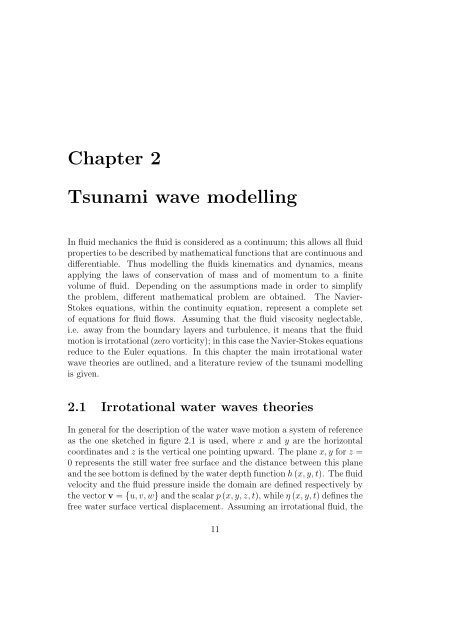Numerical modeling of waves for a tsunami early warning system
Numerical modeling of waves for a tsunami early warning system
Numerical modeling of waves for a tsunami early warning system
Create successful ePaper yourself
Turn your PDF publications into a flip-book with our unique Google optimized e-Paper software.
Chapter 2<br />
Tsunami wave modelling<br />
In fluid mechanics the fluid is considered as a continuum; this allows all fluid<br />
properties to be described by mathematical functions that are continuous and<br />
differentiable. Thus modelling the fluids kinematics and dynamics, means<br />
applying the laws <strong>of</strong> conservation <strong>of</strong> mass and <strong>of</strong> momentum to a finite<br />
volume <strong>of</strong> fluid. Depending on the assumptions made in order to simplify<br />
the problem, different mathematical problem are obtained. The Navier-<br />
Stokes equations, within the continuity equation, represent a complete set<br />
<strong>of</strong> equations <strong>for</strong> fluid flows. Assuming that the fluid viscosity neglectable,<br />
i.e. away from the boundary layers and turbulence, it means that the fluid<br />
motion is irrotational (zero vorticity); in this case the Navier-Stokes equations<br />
reduce to the Euler equations. In this chapter the main irrotational water<br />
wave theories are outlined, and a literature review <strong>of</strong> the <strong>tsunami</strong> modelling<br />
is given.<br />
2.1 Irrotational water <strong>waves</strong> theories<br />
In general <strong>for</strong> the description <strong>of</strong> the water wave motion a <strong>system</strong> <strong>of</strong> reference<br />
as the one sketched in figure 2.1 is used, where x and y are the horizontal<br />
coordinates and z is the vertical one pointing upward. The plane x, y <strong>for</strong> z =<br />
0 represents the still water free surface and the distance between this plane<br />
and the see bottom is defined by the water depth function h (x, y, t). The fluid<br />
velocity and the fluid pressure inside the domain are defined respectively by<br />
the vector v = {u, v, w} and the scalar p (x, y, z, t), while η (x, y, t) defines the<br />
free water surface vertical displacement. Assuming an irrotational fluid, the<br />
11

















